Tom's Hardware Verdict
The Toshiba N300 Pro is a decent HDD, particularly at its lower capacities. Its peak performance is good enough and NAS optimization makes it a safe choice for multi-drive environments for homelabs and small businesses, with price as always being a major factor.
Pros
- +
Good performance and pricing in the 12-18TB range
- +
Stronger warranty than the N300, IronWolf, Red Plus
- +
512MB of cache at 10TB and up
Cons
- -
Not the fastest or best-supported 20TB option
- -
Pricing and availability issues for 20TB
Why you can trust Tom's Hardware
The Toshiba N300 Pro is a big drive for big data, designed for systems with up to 24 drives with a warranty that neatly counters lesser drives like the Toshiba N300, Seagate IronWolf, and WD Red Plus. It also delivers enough performance to rival the IronWolf Pro and Red Pro. The N300 Pro is optimized for network-attached storage (NAS) where multiple drives work together in a challenging environment, making for a much more reliable solution than shucked externals. Is it one of the best hard drives? Let's find out.
The N300 Pro comes with a large cache that helps it maintain performance from 10TB and up. This makes for a more professional storage solution than your everyday WD Black or Blue, or Seagate FireCuda. The holy grail for hard drives is to get high capacity, good performance, and a solid warranty. Right now that still puts things at around 20TB and below 300 MB/s with a 5-year warranty and at least a 300TB/year workload rate limit.
Off-the-shelf consumer drives are effectively limited to 8TB, while serious storage systems need better drive density. While the average user can buy external 12TB+ HDDs and shuck away, the more reliable solution for SOHO or small businesses are drives designed for NAS environments where multiple drives operate closely together.
Optimization for this sort of environment include rotational vibration sensors and, in Toshiba’s case, larger local DRAM caches that are more efficiently utilized in multi-drive arrangements with the right data patterns and workloads. Toshiba offers more cache on many of its N300 and N300 Pro capacities — the Toshiba X300 Pro gives an alternative choice for singular drive use in high-end desktops and workstations — with a reasonable warranty that falls between the lower-end WD Red Plus and higher-end WD Red Pro. This positions the N300 Pro as a less expensive alternative to WD and Seagate — if and when pricing and availability fall in line.
Toshiba’s approach, which is due in part to its late entrance into the high-capacity game, makes the N300 Pro a surprisingly good choice within the 12–18TB capacity range. The N300 Pro can perform better in this range and can be found at reasonable prices. If you need multiple drives that don’t have to be on the cutting-edge of capacity, the N300 Pro is worth a look.
Otherwise, keep an eye on it and the competition — the WD Red Pro and Seagate IronWolf Pro — so you can grab your drives at the right moment, given that availability and pricing have been volatile. Worth noting is that the N300 Pro 20TB is a recent introduction and at present prices haven't really lined up with the rest of the series, but that's something that could easily change over time.
N300 Pro Specifications Comparison
| Product | Toshiba N300 Pro 12TB | Toshiba N300 Pro 20TB | Seagate IronWolf Pro 12TB | Seagate IronWolf Pro 20TB | WD Red Pro 12TB | WD Red Pro 20TB |
|---|---|---|---|---|---|---|
| Capacity | 12TB | 20TB | 12TB | 20TB | 12TB | 20TB |
| Model # | HDWG51EXZSTB | HDWG62AXZSTB | ST2000NE0008 | ST20000NE000 | WD121KFBX | WD201KFGX |
| Pricing | $248.90 | $439.99 | $209.99 | $349.99 | $288.14 | $378.00 |
| Cost per TB | $20.74 | $22.00 | $17.50 | $17.50 | $24.01 | $18.90 |
| Interface | SATA 6.0 Gbit/s | SATA 6.0 Gbit/s | SATA 6.0 Gbit/s | SATA 6.0 Gbit/s | SATA 6.0 Gbit/s | SATA 6.0 Gbit/s |
| Form Factor | 3.5" | 3.5" | 3.5" | 3.5" | 3.5" | 3.5" |
| Technology | CMR | CMR | CMR | CMR | CMR | CMR |
| RPM | 7200 | 7200 | 7200 | 7200 | 7200 | 7200 |
| Sustained Transfer Rate | 281 MB/s | 281 MB/s | 240 MB/s | 285 MB/s | 240 MB/s | 268 MB/s |
| Cache | 512MB | 512MB | 256MB | 256MB | 256MB | 512MB |
| Operating Power | 6.85W | 7.30W | 7.8W | 7.7W | 6.0W | 6.9W |
| Noise | 20dB (idle) | 20dB (idle) | 20dBA (idle), 26dBA (seek) | 20dBA (idle), 26dBA (seek) | 20dBA (idle), 36dBA (seek) | 20dBA (idle), 32dBA (seek) |
| Workload Rate Limit | 300TB/Yr | 300TB/yr | 300Tb/yr | 300Tb/yr | 550 TB/yr | 550TB/yr |
| MTBF | 1.2M hours | 1.2M hours | 1.2M hours | 1.2M hours | 2.5M hours | 2.5M hours |
| Warranty | 5-Year | 5-Year | 5-Year | 5-Year | 5-Year | 5-Year |
The Toshiba N300 Pro is available from 4TB up to 20TB, and today we’re looking at what would probably be the most popular capacities: 12TB and 20TB. Both capacities have the same essential specifications with 512MB of DRAM cache, a sustained transfer rate of up to 281 MB/s, and the same 5-year warranty with 300TB/year workload rate limit. 20TB is a popular size for maximum capacity while 12TB exceeds standard consumer drives and overlaps with lesser NAS drives like the WD Red Plus.
The N300 Pro’s direct competition includes the Seagate IronWolf Pro and WD Red Pro. The Red Pro has a higher workload rate limit of 550TB/year while the IronWolf Pro has models for both 300TB/year and 550TB/year, the latter mirroring the Exos X20. The N300 Pro has a larger cache than the IronWolf Pro and higher performance at 12TB but otherwise has similar specifications. The Red Pro gets 512MB of cache at 20TB and a higher MTBF. The Red Plus does have a 12TB SKU, but it’s not comparable to any of these drives.
As with the Toshiba N300, pricing and availability for drives of this caliber remain question marks. It’s important to determine what drive or drives you want and to prepare for your purchase ahead of time. WD and Seagate provide superior support, but Toshiba may be less expensive during sales and Toshiba’s technology provides a more predictable level of performance. The N300 Pro has a better warranty than the N300 and also is designed to be operated in larger storage environments, from eight to up to 24 drive systems.
Right now the N300 Pro makes the most sense in the 12-18TB range, with slightly lower price per TB. Pricing does fluctuate quite a bit, however, so keep an eye on current prices before making any final purchasing decisions.
Toshiba N300 Pro Software and Accessories
Toshiba’s software approach is fairly bare bones but that’s not the end of the world. There’s plenty of free and paid software out there for storage management, and most solutions will probably be using something other than the vendor-provided software. If you are a home user buying only a drive or two, a normal dashboard/toolbox and an OEM copy of Acronis can be convenient, but a serious NAS setup tends to be beyond what Windows and Mac users want.
A Closer Look
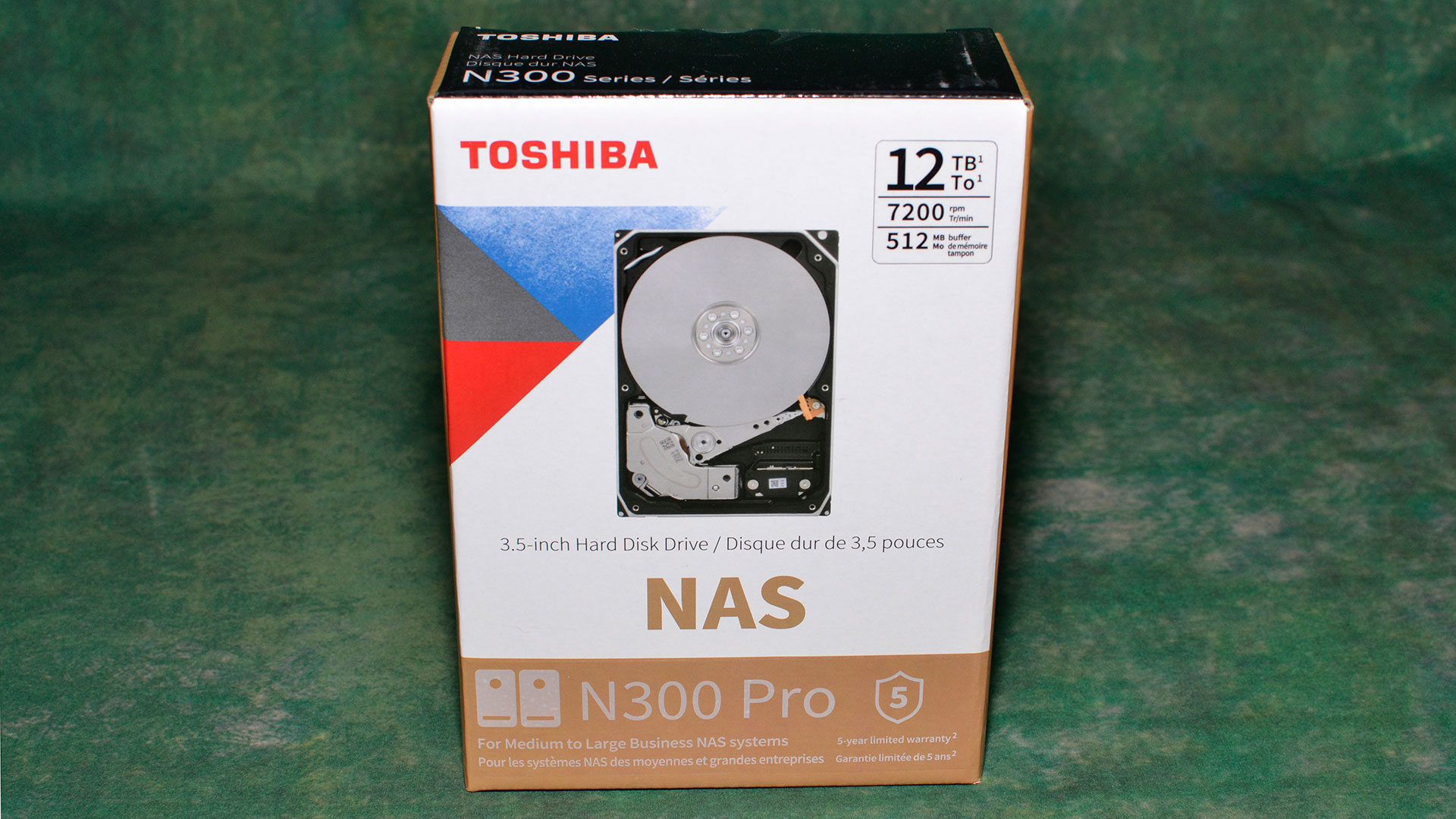
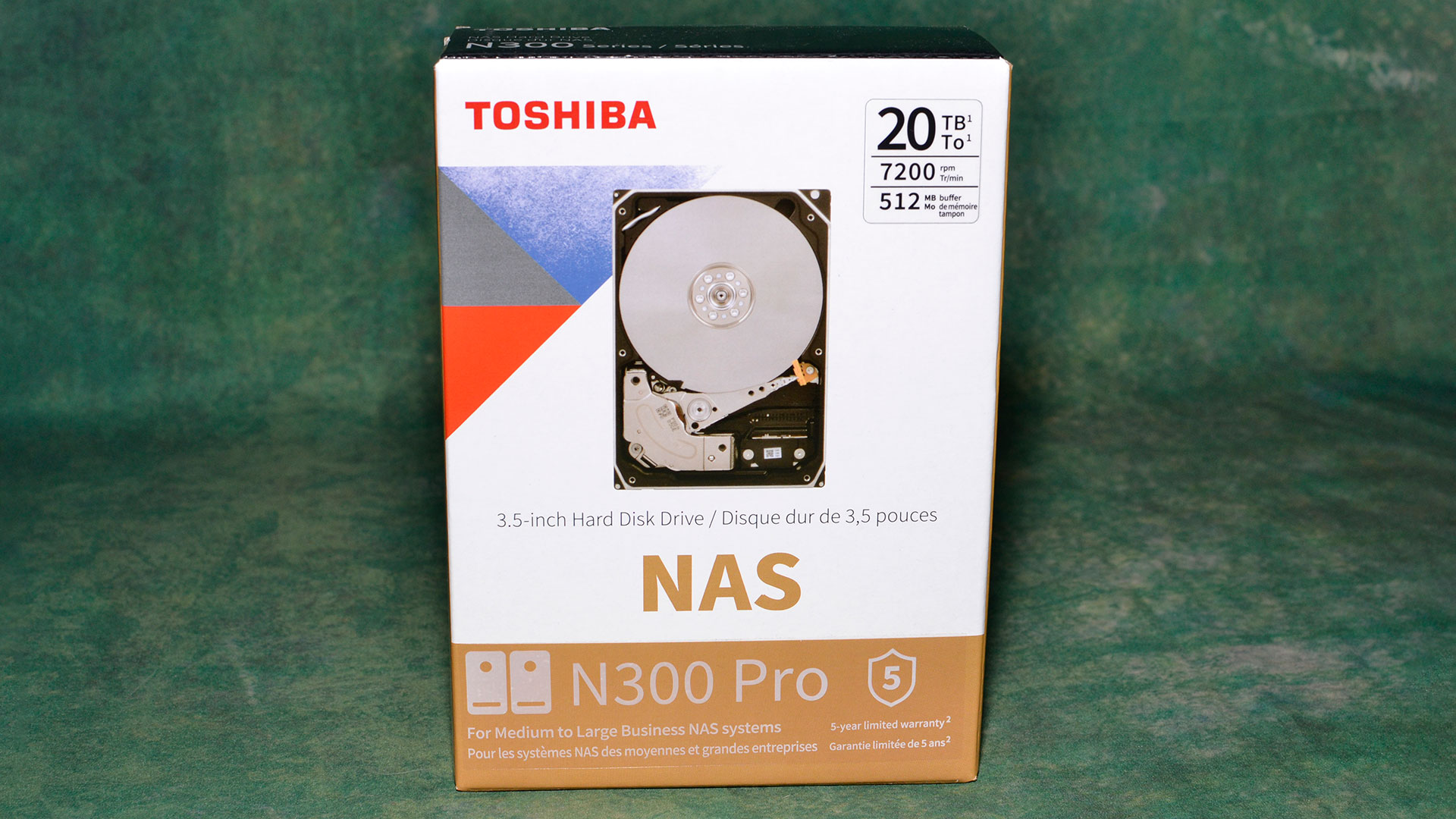
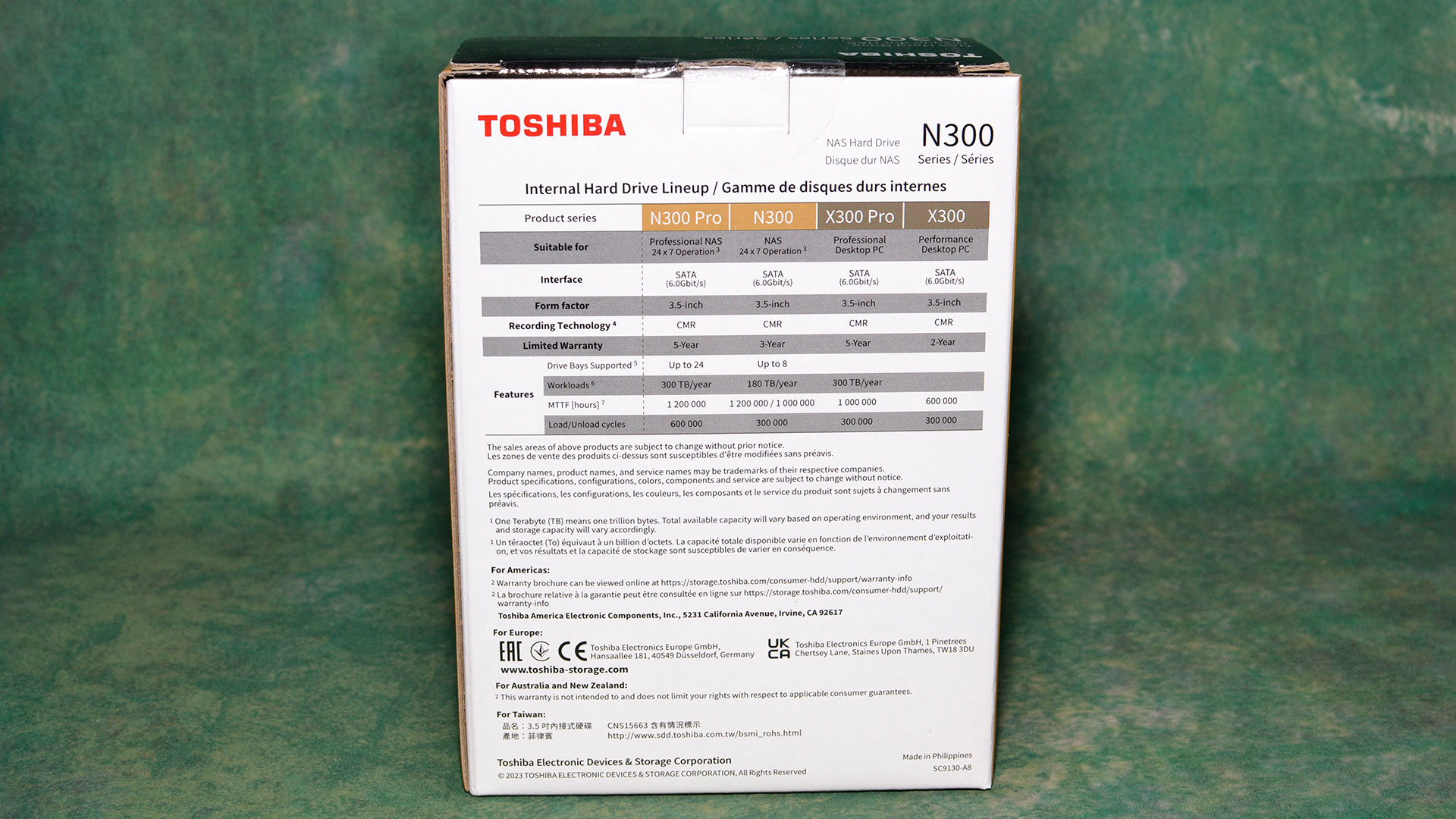
Toshiba compares the N300, N300 Pro, X300, and X300 Pro right on the back of the box. Notably, only the NAS drives are rated for systems with multiple drives, and the X300 has no workload rate limit at all. The X300’s very limited warranty but extensive capacity range makes it better suited for high-end desktop and workstation use for non-critical storage. The N300 and N300 Pro are specifically designed for use in network-attached storage systems, with inclusions like rotational vibration sensors, and the Pro models have a longer warranty for peace of mind.
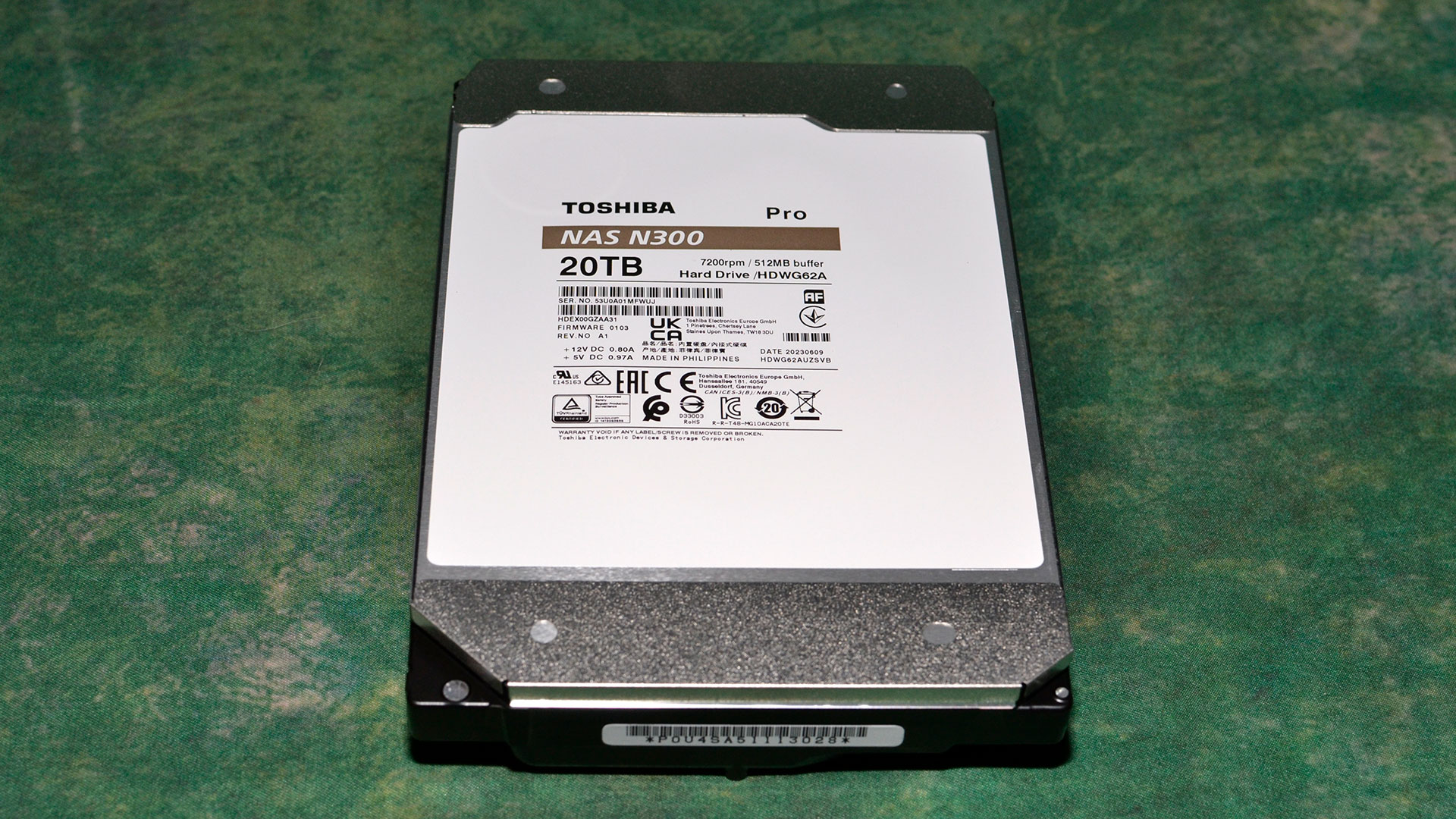
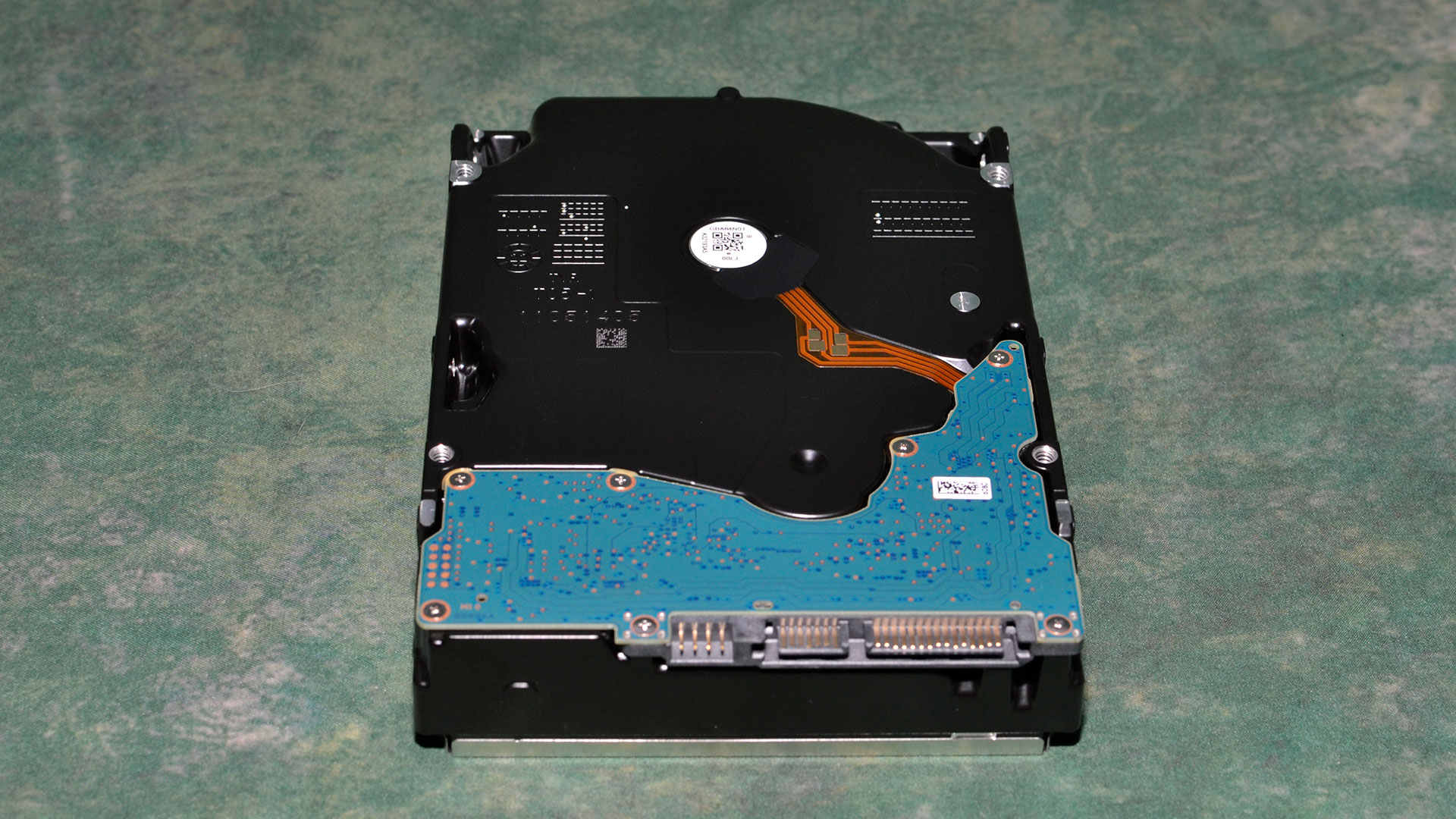

The N300 Pro is non-descript, with a simple white label. The drive is labeled “NAS N300” to indicate the drive’s purpose with Toshiba’s color-coding and “Pro” above to distinguish the two models. HDDs don’t have the flashy fanfare of consumer SSDs.
Toshiba has been interested in grabbing market share away from WD and Seagate and for that its drives must simply be capable. That is, it’s a no-frills approach, but Toshiba has focused on providing larger local caches for its drives with optimization for multi-drive/multi-bay environments. The N300 Pro’s warranty fits in-between the low- and high-end as well, providing a basic alternative.
MORE: Best Hard Drives
MORE: Best SSDs
Get Tom's Hardware's best news and in-depth reviews, straight to your inbox.
MORE: How We Test HDDs And SSDs
- 1
- 2
Current page: Toshiba N300 Pro Features and Specifications
Next Page Toshiba N300 Pro 12TB/20TB Performance Results
Shane Downing is a Freelance Reviewer for Tom’s Hardware US, covering consumer storage hardware.
-
atomicWAR Great to see more 20TB options but pricing is going to kill this with Seagate Exos drives on Newegg frequently going for 269.99 when on sale, (currently 316.99 on newegg) Toshiba will have a hard time competing in the DIY market at a 439.99.Reply -
JarredWaltonGPU Reply
Yeah, it's the difficulty with all HDDs. When there's a slightly faster, cheaper, just as large HDD already available, what exactly is the selling point of these alternatives? I also wonder if there's really that much of a difference between the NAS models and the non-NAS models that would warrant the extra cost. Given the Backblaze approach, probably not.atomicWAR said:Great to see more 20TB options but pricing is going to kill this with Seagate Exos drives on Newegg frequently going for 269.99 when on sale, (currently 316.99 on newegg) Toshiba will have a hard time competing in the DIY market at a 439.99. -
atomicWAR Reply
Yeah pretty much. If I had to take a guess on why these might be worthwhile down the road, is when these drives price correct to slot into the market better. But who knows how long that could take...JarredWaltonGPU said:Yeah, it's the difficulty with all HDDs. When there's a slightly faster, cheaper, just as large HDD already available, what exactly is the selling point of these alternatives? I also wonder if there's really that much of a difference between the NAS models and the non-NAS models that would warrant the extra cost. Given the Backblaze approach, probably not. -
palladin9479 ReplyJarredWaltonGPU said:Yeah, it's the difficulty with all HDDs. When there's a slightly faster, cheaper, just as large HDD already available, what exactly is the selling point of these alternatives? I also wonder if there's really that much of a difference between the NAS models and the non-NAS models that would warrant the extra cost. Given the Backblaze approach, probably not.
There is a difference in the firmware and how the drive handles speeding up and down. NAS drives are spinning 24/7/365, they only spin up or down during restarts of the SP. Regular drives on the other hand will attempt to save power by spinning up / down on demand. This can cause lifetime reliability issues as the drive experiences the most stress when it's spinning up. Also there can be thermal considerations, regular drives know that they are primarily accessed in bursts and won't be expected to go 24/7/365, so they don't vent heat as well. NAS drives are expected to be rotating all the time and have better sustained thermal design.
I built my own NAS using FreeNAS and common parts off newegg/amazon. I made the mistake on my first array of using 7200RPM desktop performance drives. Ended up being a nightmare with thermals and I then swapped them for 5400RPM power saving drives, worked for awhile but then started having all sorts of problems. Finally bit the bullet and switched to 4x4TB WD Red 5400 and haven't had any problems in years. This system not only does typical CIFS shares for the house, but also iSCSI volumes for my ESXI system where I do lab work. -
JarredWaltonGPU Reply
Good to know it can actually make a difference, though I’d love to see someone do long-term testing with modern HDDs like the X300 Pro 20TB and N300 Pro 20TB. I’m sure the hardware is nearly the same (economies of scale being a big factor), and specs are otherwise very similar. Going from one set of 4TB 7200 RPM drives to a completely different set of 4TB 5400 RPM drives is obviously a significant change in the internal hardware.palladin9479 said:There is a difference in the firmware and how the drive handles speeding up and down. NAS drives are spinning 24/7/365, they only spin up or down during restarts of the SP. Regular drives on the other hand will attempt to save power by spinning up / down on demand. This can cause lifetime reliability issues as the drive experiences the most stress when it's spinning up. Also there can be thermal considerations, regular drives know that they are primarily accessed in bursts and won't be expected to go 24/7/365, so they don't vent heat as well. NAS drives are expected to be rotating all the time and have better sustained thermal design.
I built my own NAS using FreeNAS and common parts off newegg/amazon. I made the mistake on my first array of using 7200RPM desktop performance drives. Ended up being a nightmare with thermals and I then swapped them for 5400RPM power saving drives, worked for awhile but then started having all sorts of problems. Finally bit the bullet and switched to 4x4TB WD Red 5400 and haven't had any problems in years. This system not only does typical CIFS shares for the house, but also iSCSI volumes for my ESXI system where I do lab work.
I don’t use HDDs much these days, but I also tend to turn off the drive power down feature in Windows because I don’t want to have to wait for a drive to spin back up. I’ve heard in the past that spin up/spin down is one of the hardest things on HDDs in terms of wear and tear as well.